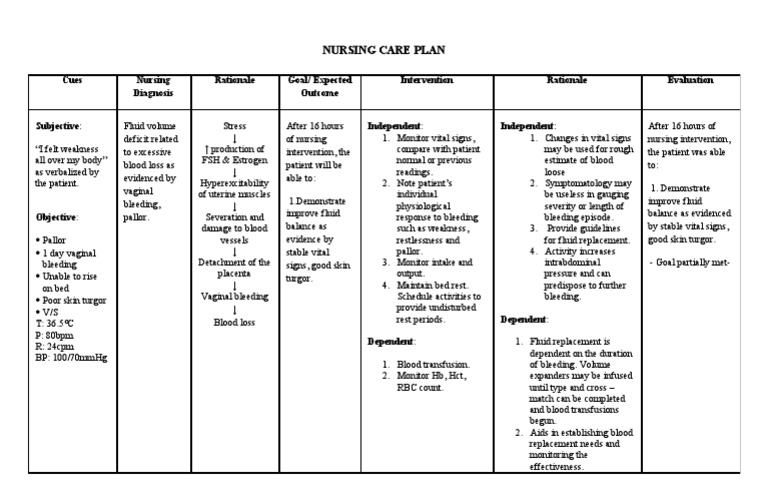Your Fluid volume deficit care plan images are ready. Fluid volume deficit care plan are a topic that is being searched for and liked by netizens now. You can Get the Fluid volume deficit care plan files here. Get all royalty-free photos.
If you’re searching for fluid volume deficit care plan images information related to the fluid volume deficit care plan keyword, you have come to the right site. Our site frequently gives you hints for seeking the highest quality video and picture content, please kindly hunt and locate more informative video articles and graphics that fit your interests.
Fluid Volume Deficit Care Plan. Risk for fluid volume deficit: Child will not experience deficient fluid volume by (date/time to evaluate). Nusing care plan (ncp) for deydration & fluid volume deficit: Fluid volume deficit (dehydration) is a state or condition where the fluid output exceeds the fluid intake.

This helps ensure adequate fluid volumes are restored and maintained and the risk for fluid volume deficit is minimized. Oral fluid replacement is indicated for mild fluid deficit. The patient will have a stable fluid volume as evidenced by normal blood pressure, at least 30ml hourly urine output, and elastic skin turgor. Monitor and document vital signs, especially bp and hr. > exhibit moist mucous membrane and good skin turgor. Fluid volume deficit related to dehydration due to fever as evidenced by temperature of 39.0 degrees celsius, skin turgidity, dark yellow urine output, profuse sweating, and blood pressure of 89/58.
To promote interest in drinking.
Fluid volume deficit related to loss of fluid and electrolytes as manifested by vomiting. Fluid volume deficit (dehydration) is a state or condition where the fluid output exceeds the fluid intake. Hemorrhage is one of the common causes of maternal mortality associated with childbearing and is the major immediate danger during the postpartal period. Monitor urine color and specific gravity. Administer fluid parenterally and provide the antidiarrheal drugs as per prescription. Fluid volume deficit related to dehydration due to fever as evidenced by temperature of 39.0 degrees celsius, skin turgidity, dark yellow urine output, profuse sweating, and blood pressure of 89/58.

The patient appears pale and lethargic; Nursing interventions for excess fluid volume. The patient will have a stable fluid volume as evidenced by normal blood pressure, at least 30ml hourly urine output, and elastic skin turgor. The nursing goals for patients with acute gastroenteritis are toward avoiding dehydration and management of diarrhea. Nursing assessment for fluid volume deficit.

Nursing interventions for excess fluid volume. (specify, e.g., child states it hurts to drink, decreased intake [specify amount]; The nursing goals for patients with acute gastroenteritis are toward avoiding dehydration and management of diarrhea. Fluid volume deficit, gastrointestinal (gi) bleed, dehydration, hemorrhage, hypotension, and abdominal pain as the main problems identified in the patient assessment. Stool sample positive for occult blood;
 Source: pinterest.com.au
Source: pinterest.com.au
Nursing care plan (form #7) assessment diagnosis planning implementation scientific rationale evaluation/ reassessment subjective: Nusing care plan (ncp) for deydration & fluid volume deficit: Encourage/remind patient of the need for oral intake. Fluid volume deficit may be an acute or chronic condition managed in the hospital, outpatient. Nursing care plan (form #7) assessment diagnosis planning implementation scientific rationale evaluation/ reassessment subjective:

Position patient comfortably on the bed and maintain the room temperature at a comfortable level. Fluid volume deficit (dehydration) is a state or condition where the fluid output exceeds the fluid intake. Monitor urine color and specific gravity. (specify, e.g., child states it hurts to drink, decreased intake [specify amount]; Inadequate oral intake, excessive losses through abnormal route.

A caregiver should begin by looking out for the most common signs and exposure to likely causes. After 8 hours of nursing intervention, the patient will be able to: Fluid volume deficit, gastrointestinal (gi) bleed, dehydration, hemorrhage, hypotension, and abdominal pain as the main problems identified in the patient assessment. Maintain accurate i & o record. Nursing interventions for excess fluid volume.

Also, assess for edema in lower extremities and other areas of the body where conditions are conducive to swelling such as feet, ankles, legs, hands, arms. Also, assess for edema in lower extremities and other areas of the body where conditions are conducive to swelling such as feet, ankles, legs, hands, arms. A decrease in circulating blood volume can cause hypotension and tachycardia. It happens when water and electrolytes are lost as they exist in normal body fluids. Monitor urine color and specific gravity.
 Source: pinkkactis.tumblr.com
Source: pinkkactis.tumblr.com
Monitor serum electrolyte levels regularly. Nusing care plan (ncp) for deydration & fluid volume deficit: Parenteral fluid replacement is indicated to prevent shock. Common sources are the gastrointestinal tract, polyuria, and increased perspiration. Nursing care plan (form #7) assessment diagnosis planning implementation scientific rationale evaluation/ reassessment subjective:

Enforce fluid restrictions and educate on the importance. To help determine developing electrolyte imbalances and to correct them early on. By admin in november 27th 2009 comments off on fluid volume deficit care plan filed under nursing care plans tags: This helps ensure adequate fluid volumes are restored and maintained and the risk for fluid volume deficit is minimized. Encourage/remind patient of the need for oral intake.

Deficient fluid volume related to lack of fluid intake a patient should maintain the normal blood pressure a patient should have a balance intake and output of the fluid and stable weight a patient should have a clear and good sound of lungs a patient This post contains 4 nursing care plans and 3 possible nursing diagnoses for age. Goal and objectives after 8 hours of nursing interventions, the patient will maintain adequate fluid volume as evidenced by good skin turgor and balance intake and output. To promote interest in drinking. Fluid volume deficit related to dehydration due to fever as evidenced by temperature of 39.0 degrees celsius, skin turgidity, dark yellow urine output, profuse sweating, and blood pressure of 89/58.

Urine output of at least 30ml per hour indicates adequate perfusion of the kidneys. Maintain accurate i & o record. Fluid volume deficit related to loss of fluid and electrolytes as manifested by vomiting. Fluid volume deficit related to dehydration due to fever as evidenced by temperature of 39.0 degrees celsius, skin turgidity, dark yellow urine output, profuse sweating, and blood pressure of 89/58. Monitor early sign and symptoms of fluid volume deficit like decreases skin turgor, dry mucus membrane, and urine specific gravity >1.025.

The patient appears pale and lethargic; A decrease in circulating blood volume can cause hypotension and tachycardia. Goal and objectives after 8 hours of nursing interventions, the patient will maintain adequate fluid volume as evidenced by good skin turgor and balance intake and output. A caregiver should begin by looking out for the most common signs and exposure to likely causes. Risk for deficient fluid volume.

As individuals age sometimes there is a loss of thirst, reminding and encouraging individuals may help them to remember the need to continue drinking fluids even if they do not feel they are thirsty. If a fluid restriction is ordered, the nurse should educate the patient and their family on the reason for better adherence. Hemorrhage is one of the common causes of maternal mortality associated with childbearing and is the major immediate danger during the postpartal period. Fluid volume deficit (dehydration) is a state or condition where the fluid output exceeds the fluid intake. The body loses both water and electrolytes from the ecf in similar proportions.

> exhibit moist mucous membrane and good skin turgor. Fluid restrictions prevent the patient from taking in too much extra fluid. This refers to dehydration, water loss alone without change in sodium. Child will not experience deficient fluid volume by (date/time to evaluate). Inadequate oral intake, excessive losses through abnormal route.

Decreased intravascular, interstitial, and/or intracellular fluid. Fluid volume deficit, or hypovolemia, occurs from a loss of body fluid or the shift of fluids into the third space, or from a reduced fluid intake. Monitor urine color and specific gravity. This helps ensure adequate fluid volumes are restored and maintained and the risk for fluid volume deficit is minimized. As individuals age sometimes there is a loss of thirst, reminding and encouraging individuals may help them to remember the need to continue drinking fluids even if they do not feel they are thirsty.

Assessment is necessary to identify potential problems that may have led to fluid volume deficit and name any episode that may occur during nursing care. Parenteral fluid replacement is indicated to prevent shock. Urine output of at least 30ml per hour indicates adequate perfusion of the kidneys. Here are ten (10) nursing care plans (ncp) and nursing diagnosis for fluid and electrolyte imbalances, more specifically: Enforce fluid restrictions and educate on the importance.
 Source: pinterest.com
Source: pinterest.com
Administer fluid parenterally and provide the antidiarrheal drugs as per prescription. Elderly patients are especially susceptible to fluid overload. This post contains 4 nursing care plans and 3 possible nursing diagnoses for age. Administer intravenous hydration if needed. Fluid volume deficit, or hypovolemia, occurs from a loss of body fluid or the shift of fluids into the third space, or from a reduced fluid intake.
 Source: pinterest.com
Source: pinterest.com
Monitor urine color and specific gravity. Nursing care plan (form #7) assessment diagnosis planning implementation scientific rationale evaluation/ reassessment subjective: (specify, e.g., child states it hurts to drink, decreased intake [specify amount]; Less than that may indicate insufficient fluid volume. Deficient fluid volume is a state or condition where the fluid output exceeds the fluid intake.

Elderly patients are especially susceptible to fluid overload. Early detection of fluid deficit helps to replenish adequate fluid in the body. Position patient comfortably on the bed and maintain the room temperature at a comfortable level. Encourage/remind patient of the need for oral intake. Administer fluid parenterally and provide the antidiarrheal drugs as per prescription.
This site is an open community for users to submit their favorite wallpapers on the internet, all images or pictures in this website are for personal wallpaper use only, it is stricly prohibited to use this wallpaper for commercial purposes, if you are the author and find this image is shared without your permission, please kindly raise a DMCA report to Us.
If you find this site helpful, please support us by sharing this posts to your preference social media accounts like Facebook, Instagram and so on or you can also bookmark this blog page with the title fluid volume deficit care plan by using Ctrl + D for devices a laptop with a Windows operating system or Command + D for laptops with an Apple operating system. If you use a smartphone, you can also use the drawer menu of the browser you are using. Whether it’s a Windows, Mac, iOS or Android operating system, you will still be able to bookmark this website.





